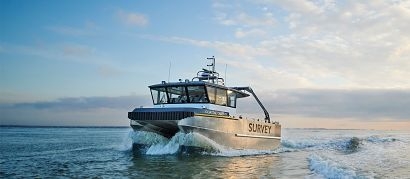
The broader trend for workboats – which includes OESVS, tugs, pilot vessels and survey vessels – in many key markets globally shows a clear and increasingly assertive move towards emissions reduction. The Clean Maritime Plan for net-zero emissions in domestic UK waters by 2050 is one example, while the EPA Tier 4 air quality regulations offers practical guidance at present for vessel operators in the US.
Hybrid designs are being trialled and successfully adopted across the industry and will continue to play a critical role in current and future decarbonisation strategies. Chartwell Marine’s own vessel portfolio includes the Chasewell pilot & patrol boat and Scanwell survey vessel range – both with hybrid propulsion options.
However, with all workboat types, the financial factor may well prove decisive. Reducing fuel burn and finding more efficient ways to work leads to increased profitability across vessel operations. Chartwell Marine warns that although hybrid and electric solutions are ideally suited for some contexts, the operational profile of the vessel must be carefully considered. Designing vessels with end user requirements in mind is a vital part of ensuring that they act effectively.
The port sector has struggled with NOx pollution, produced in large part by vessel operations. There are many areas where hybrid propulsion offers clear benefits outside of the obvious emissions reduction. Hybrid propulsion systems are especially effective for vessels operating at reduced speeds, such as those working in and around ports. Reducing fuel burn in port dramatically while utilising increased torque from a hybrid system will improve operational efficiency for tug-boats, for example.
Hybrid technology is ideally suited for the survey sector too due to dramatic reductions in acoustic interference. Quieter operations mean more accurate surveying, whether that is for scientific purposes, installation and maintenance of subsea infrastructure or port dredging.
In offshore wind, there are clear incentives for the decarbonisation of crew transfer vessels, as the industry looks to bolster its green credentials. However, high speed offshore wind CTVs are often less suitable for alternative propulsion because the power densities of energy sources such as batteries and hydrogen are not currently as efficient as diesel. In this case, smart and holistic vessel design is the most effective way forward. When a focus on the high-speed operational element prevails, Chartwell Marine look towards the potential of using a combination of increased dynamic lift, active motion damping and AI to increase operational efficiency.
“Alternative propulsion systems and energy sources are an exciting proposition, and in many operational contexts already offer the best solution in terms of efficiency” said Andy Page, Managing Director, Chartwell Marine. “But as global operators increasingly look to enhance the efficiency of their fleets, it’s worth considering that existing innovations in hull forms and other vessel technologies often have the greatest capacity to deliver savings. A strategic element is in play here as a diverse set of markets look to reduce their emissions. While it’s certainly encouraging that stimulus from above is spurring research and development in the workboat sector, it is ultimately up to naval architects, engineers and vessel operators to enable the necessary efficiency savings to be made.”
Chartwell Marine was awarded a prize by the Carbon Trust last year for their part in designing an innovative new hull form for the Offshore Wind Accelerator competition and is currently working on the development and testing of technologies to aid the ongoing decarbonisation of vessels.
For additional information:

